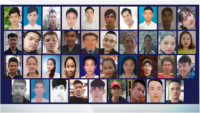Last Updated on April 1, 2022 by themigrationnews
Compared to animals, humans have a unique ability: we can dream. Our dreams differ greatly, but we all want to live amidst goodness and abundance. And for this, people are willing to pay a high price, even if it means risking their lives. Although most migration is voluntary and beneficial to individuals and societies, it can increase vulnerability to human trafficking and exploitation. How dangerous can the road to a new life be? Dreams of a new and beautiful life do not always come true. A tragic situation occurred for 39 Vietnamese citizens who wanted to start a new life with all their might, but their dreams were not to be realised.
The documentary film “Hunting the Essex Lorry Killers,” directed by Niamh Kennedy and produced by Jess Austin in 2021, depicts only a small portion of the global problem of human trafficking and people smuggling (BBC and Expectation Entertainment, 2021). The film is based on true events and tells the story of 39 undocumented Vietnamese immigrants who tried to enter the United Kingdom using the services of smugglers.
On October 23, 2019, shortly after midnight, police received a call from a lorry driver, who stated that there were approximately 25 dead people in his lorry. Eight hours after the bodies were discovered in the lorry, police took the lorry to a special location where the identification of the deceased could begin. Initially, determining the cause of death of these people was difficult for the police. This was because of two reasons. First, people were in a refrigerated container, and second, they were almost all undressed. A post-mortem examination revealed that these people died because of suffocation. The use of modern technology significantly assisted British police in determining the time, place, and cause of death of all 39 individuals. The temperature inside the refrigerated container with the migrants trapped inside had reached a maximum of 38.5 degrees, and the container was already in British waters on its way to the destination port when all the migrants had died.
This film vividly depicts how criminal gangs profit from irregular migration, the structure of this criminal gang, and who were involved in it: from the smallest figures, such as a lorry driver, to the boss of this organisation. This film shows the organization’s operational mechanisms as well as the motivations that drive people to engage in illegal activity. This film also demonstrates how many employees from various police departments were involved. This case was quickly solved due to the efforts of law enforcement officers from various countries. The interviews with family members of the deceased migrants are the most emotional parts of this film. The print screens of migrants’ correspondence with members of their families, shown throughout the film, are completely shocking to a viewer, especially when some of the migrants are near death and write phrases like “Mom, I love you” or “it’s hard for me to breathe.”The film also gives a viewer the impression that he is personally acquainted with the deceased, as the film contains many personal photographs from migrants’ lives; a viewer can hear their voices, see their family members, see the places where they lived, and see their journey from Vietnam to the United Kingdom, as many of them took photos during their journey.
In terms of information content, the film is generally very well prepared. The film contains a lot of documentary videos provided by law enforcement agencies, as well as video interviews and photo documents made in collaboration with the victims’ families, along with video interviews with all participating civil society organisations that assisted in the investigation. This film used a video interview with a person who took the same route as the 39 migrants and the narration of his story and experiences was employed to demonstrate that this was not an isolated case and that this gang escorted people to the territory of Britain in this manner on a regular basis.
Why should a viewer see this film? First and foremost, this film serves as a warning to people who wish to enter another country illicitly, as it clearly demonstrates how such a journey can end. It depicts all the dangers associated with irregular migration. Second, for those who work in law enforcement, this film will show how law enforcement operates in such situations. Third, this film assists in identifying the so-called red flags that can be useful to the public in recognising when someone is in trouble, some red flags that can be very similar to those that identifies human trafficking or people smuggling.
The film makes it clear, in my opinion, that in developing and donor countries, special attention and assistance are needed for people who want to immigrate because this group of people is the most vulnerable to smuggling. Poverty is frequently mentioned as a risk factor for modern slavery, and relative wealth disparities between countries are frequently mentioned as a pull factor (International Labour Organization and Walk Free Foundation, 2017). This film exposes the problem of irregular migration and demonstrates that irregular immigration is not only dangerous for migrants themselves, but also for their families and host countries. If we consider the problem of undocumented migration in a broad sense, this film undoubtedly contributes to our understanding of the global economy and geopolitics.

Given that there were 5.4 victims of modern slavery for every thousand people in the world in 2016 (International Labour Organization and Walk Free Foundation, 2017), the death of these 39 Vietnamese undocumented immigrants may appear to be a drop in the ocean, but if this particular case sparked such a storm of emotions in the press, imagine how many films we would have to see if films were made on all episodes of undocumented migration.
After viewing this film, one should consider what is good and evil in the context of global migration. How can one help with the problem of irregular migration, and where do you stand: on the side of someone who assists people in crisis, or as a silent observer? Consider how serious the problem of human trafficking and smuggling is after watching this film. If you believe it is a massive issue, and if it appears to you that this is a tragedy not only for migrants but also for their families and for humanity, perhaps it is time to act?
References:
BBC and Expectation Entertainment (2021). Hunting the Essex Lorry Killers. [online] BBC. Available at: https://www.bbc.co.uk/programmes/m0010ldl [Accessed 6 Feb. 2022].
International Labour Organization and Walk Free Foundation (2017). Global estimates of modern slavery: forced labor and forced marriage. [online] Geneva: International Labour Organization. Available at: https://www.ilo.org/wcmsp5/groups/public/—dgreports/—dcomm/documents/publication/wcms_575479.pdf [Accessed 13 Feb. 2022].

Julija Kozlova has a BSc in Environmental Science and is currently pursuing an MSc in Migration. She worked as an intern at the European Commission’s EUROSTAT F3 Unit: Labour Market in Luxembourg in 2021. Julija speaks Latvian, English, and Russian fluently.
